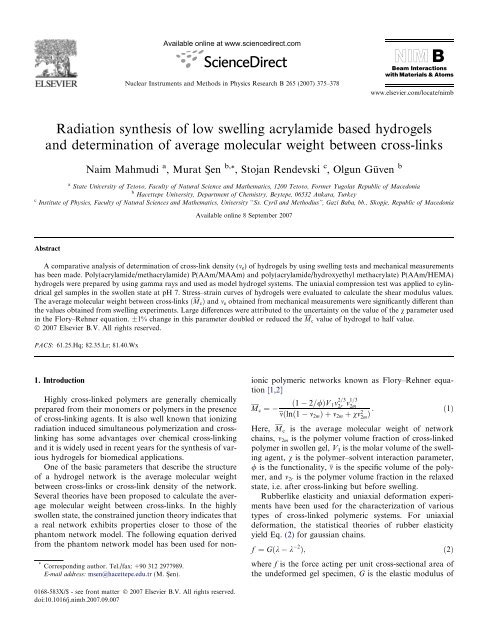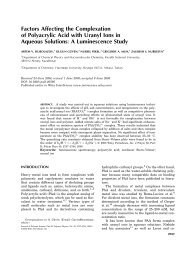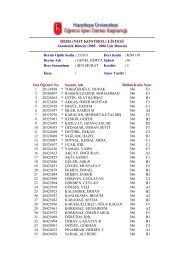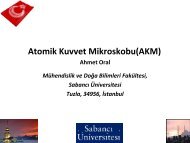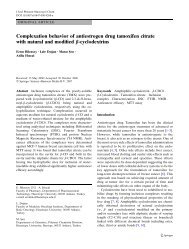Radiation synthesis of low swelling acrylamide based hydrogels and ...
Radiation synthesis of low swelling acrylamide based hydrogels and ...
Radiation synthesis of low swelling acrylamide based hydrogels and ...
Create successful ePaper yourself
Turn your PDF publications into a flip-book with our unique Google optimized e-Paper software.
Available online at www.sciencedirect.com<br />
Nuclear Instruments <strong>and</strong> Methods in Physics Research B 265 (2007) 375–378<br />
NIM B<br />
Beam Interactions<br />
with Materials & Atoms<br />
www.elsevier.com/locate/nimb<br />
<strong>Radiation</strong> <strong>synthesis</strong> <strong>of</strong> <strong>low</strong> <strong>swelling</strong> <strong>acrylamide</strong> <strong>based</strong> <strong>hydrogels</strong><br />
<strong>and</strong> determination <strong>of</strong> average molecular weight between cross-links<br />
Naim Mahmudi a , Murat Sßen b, *, Stojan Rendevski c , Olgun Güven b<br />
a State University <strong>of</strong> Tetovo, Faculty <strong>of</strong> Natural Science <strong>and</strong> Mathematics, 1200 Tetovo, Former Yugolav Republic <strong>of</strong> Macedonia<br />
b Hacettepe University, Department <strong>of</strong> Chemistry, Beytepe, 06532 Ankara, Turkey<br />
c Institute <strong>of</strong> Physics, Faculty <strong>of</strong> Natural Sciences <strong>and</strong> Mathematics, University ‘‘Ss. Cyril <strong>and</strong> Methodius’’, Gazi Baba, bb., Skopje, Republic <strong>of</strong> Macedonia<br />
Available online 8 September 2007<br />
Abstract<br />
A comparative analysis <strong>of</strong> determination <strong>of</strong> cross-link density (m e ) <strong>of</strong> <strong>hydrogels</strong> by using <strong>swelling</strong> tests <strong>and</strong> mechanical measurements<br />
has been made. Poly(<strong>acrylamide</strong>/meth<strong>acrylamide</strong>) P(AAm/MAAm) <strong>and</strong> poly(<strong>acrylamide</strong>/hydroxyethyl methacrylate) P(AAm/HEMA)<br />
<strong>hydrogels</strong> were prepared by using gamma rays <strong>and</strong> used as model hydrogel systems. The uniaxial compression test was applied to cylindrical<br />
gel samples in the swollen state at pH 7. Stress–strain curves <strong>of</strong> <strong>hydrogels</strong> were evaluated to calculate the shear modulus values.<br />
The average molecular weight between cross-links ðM c Þ <strong>and</strong> m e obtained from mechanical measurements were significantly different than<br />
the values obtained from <strong>swelling</strong> experiments. Large differences were attributed to the uncertainty on the value <strong>of</strong> the v parameter used<br />
in the Flory–Rehner equation. ±1% change in this parameter doubled or reduced the M c value <strong>of</strong> hydrogel to half value.<br />
Ó 2007 Elsevier B.V. All rights reserved.<br />
PACS: 61.25.Hq; 82.35.Lr; 81.40.Wx<br />
1. Introduction<br />
* Corresponding author. Tel./fax: +90 312 2977989.<br />
E-mail address: msen@hacettepe.edu.tr (M. Sßen).<br />
Highly cross-linked polymers are generally chemically<br />
prepared from their monomers or polymers in the presence<br />
<strong>of</strong> cross-linking agents. It is also well known that ionizing<br />
radiation induced simultaneous polymerization <strong>and</strong> crosslinking<br />
has some advantages over chemical cross-linking<br />
<strong>and</strong> it is widely used in recent years for the <strong>synthesis</strong> <strong>of</strong> various<br />
<strong>hydrogels</strong> for biomedical applications.<br />
One <strong>of</strong> the basic parameters that describe the structure<br />
<strong>of</strong> a hydrogel network is the average molecular weight<br />
between cross-links or cross-link density <strong>of</strong> the network.<br />
Several theories have been proposed to calculate the average<br />
molecular weight between cross-links. In the highly<br />
swollen state, the constrained junction theory indicates that<br />
a real network exhibits properties closer to those <strong>of</strong> the<br />
phantom network model. The fol<strong>low</strong>ing equation derived<br />
from the phantom network model has been used for nonionic<br />
polymeric networks known as Flory–Rehner equation<br />
[1,2]<br />
ð1 2=/ÞV 1 m 2=3<br />
2r<br />
M c ¼<br />
m1=3 2m<br />
mðlnð1<br />
m 2m Þþm 2m þ vm 2 2mÞ : ð1Þ<br />
Here, M c is the average molecular weight <strong>of</strong> network<br />
chains, m 2m is the polymer volume fraction <strong>of</strong> cross-linked<br />
polymer in swollen gel, V 1 is the molar volume <strong>of</strong> the <strong>swelling</strong><br />
agent, v is the polymer–solvent interaction parameter,<br />
/ is the functionality, m is the specific volume <strong>of</strong> the polymer,<br />
<strong>and</strong> m 2r is the polymer volume fraction in the relaxed<br />
state, i.e. after cross-linking but before <strong>swelling</strong>.<br />
Rubberlike elasticity <strong>and</strong> uniaxial deformation experiments<br />
have been used for the characterization <strong>of</strong> various<br />
types <strong>of</strong> cross-linked polymeric systems. For uniaxial<br />
deformation, the statistical theories <strong>of</strong> rubber elasticity<br />
yield Eq. (2) for gaussian chains.<br />
f ¼ Gðk k 2 Þ; ð2Þ<br />
where f is the force acting per unit cross-sectional area <strong>of</strong><br />
the undeformed gel specimen, G is the elastic modulus <strong>of</strong><br />
0168-583X/$ - see front matter Ó 2007 Elsevier B.V. All rights reserved.<br />
doi:10.1016/j.nimb.2007.09.007
376 N. Mahmudi et al. / Nucl. Instr. <strong>and</strong> Meth. in Phys. Res. B 265 (2007) 375–378<br />
the sample, <strong>and</strong> k is the deformation ratio (deformed<br />
length/initial length). For a homogenous network <strong>of</strong><br />
gaussian chains, the elastic modulus <strong>of</strong> gel swollen to<br />
equilibrium, G, is related to the network cross-link density<br />
by Eq. (3) [3].<br />
G ¼ A q M c<br />
RT m 2=3<br />
2r m1=3 2m ;<br />
where q is the polymer density. The prefactor A, equals 1<br />
for an affine network <strong>and</strong> (1 2//) for a phantom<br />
network.<br />
The effective cross-link density, m e , <strong>of</strong> a cross-linked<br />
structure can be obtained from the results <strong>of</strong> compressive<br />
strain measurements using Eqs. (2)–(4):<br />
M c ¼ q m e<br />
:<br />
In our previous studies we have shown that simple compression<br />
analyses <strong>and</strong> equations derived from phantom<br />
network theory can be used for the determination <strong>of</strong> effective<br />
cross-link density <strong>of</strong> highly swollen <strong>hydrogels</strong> without<br />
needing some polymer-solvent <strong>based</strong> parameters as in the<br />
case <strong>of</strong> <strong>swelling</strong> [4].<br />
In this study we compared <strong>swelling</strong> <strong>and</strong> mechanical<br />
analyses for the determination <strong>of</strong> cross-link density <strong>of</strong><br />
<strong>hydrogels</strong> prepared by ionizing radiation with relatively<br />
<strong>low</strong> degree <strong>of</strong> <strong>swelling</strong>.<br />
2. Experimental<br />
Four components were used in the preparation <strong>of</strong> <strong>acrylamide</strong>–meth<strong>acrylamide</strong>–methylenebis<strong>acrylamide</strong><br />
(AAm/<br />
MAAm/MBA/water) <strong>and</strong> <strong>acrylamide</strong>–2-hydroxyethyl<br />
methacrylate–methylenebis<strong>acrylamide</strong> (AAm/HEMA/<br />
MBA/water) <strong>hydrogels</strong>, namely <strong>acrylamide</strong>, meth<strong>acrylamide</strong>,<br />
<strong>and</strong> 2-hydroxyethyl methacrylate as monomers <strong>and</strong><br />
methylenebis<strong>acrylamide</strong> as the cross-linking agents <strong>and</strong><br />
water as dispersing medium. The mass proportion <strong>of</strong> the<br />
monomers in the initial mixtures is summarized in Table 1.<br />
The AAm/MAAm/MBA/water <strong>and</strong> AAm/HEMA/<br />
MBA/water solutions were placed in PVC straws <strong>of</strong><br />
3 mm diameter <strong>and</strong> irradiated at 15 kGy <strong>and</strong> 6.6 kGy<br />
doses, respectively. They have been determined to be minimum<br />
doses corresponding to complete conversion. Fresh<br />
ð3Þ<br />
ð4Þ<br />
<strong>hydrogels</strong> obtained in long cylindrical shapes were cut into<br />
pieces 3–4 mm in length. Unreacted monomer <strong>and</strong> uncrosslinked<br />
polymers were removed by washing the gels for two<br />
days in distilled water. They were dried in vacuum oven in<br />
315 K. Percentage gelation i.e. percentage conversion <strong>of</strong><br />
monomers <strong>and</strong> cross-linking agent into insoluble networks,<br />
was <strong>based</strong> on the total weight <strong>of</strong> the cross-linking agent<br />
<strong>and</strong> monomers in the initial mixture. Washed <strong>and</strong> dried<br />
<strong>hydrogels</strong> were left to swell in distilled water at room temperature<br />
to determine the parameters <strong>of</strong> <strong>swelling</strong>. Swollen<br />
gels removed from the water bath at regular intervals were<br />
dried superficially with filter paper, weighed <strong>and</strong> immediately<br />
placed in the same bath still in equilibrium <strong>swelling</strong><br />
state. Elastic properties <strong>and</strong> shear modulus <strong>of</strong> <strong>hydrogels</strong><br />
were determined by using a Zwick Z010 model Universal<br />
Testing Instrument <strong>and</strong> uniaxial compression module.<br />
The crosshead speed was 5 mm/min.<br />
3. Results <strong>and</strong> discussion<br />
3.1. Swelling behavior <strong>of</strong> <strong>hydrogels</strong><br />
For the characterization <strong>of</strong> the network structure <strong>and</strong><br />
determination <strong>of</strong> effective cross-link density <strong>of</strong> prepared<br />
<strong>hydrogels</strong> their <strong>swelling</strong> behavior at pH 7 was first investigated.<br />
The percentage <strong>swelling</strong> <strong>of</strong> <strong>hydrogels</strong> was calculated<br />
by the fol<strong>low</strong>ing equation;<br />
S%ðmÞ ¼½ðm t m o Þ=m o Š100;<br />
where m t <strong>and</strong> m o are the weights <strong>of</strong> the swollen <strong>and</strong> dry gels<br />
respectively.<br />
Representative <strong>swelling</strong> curves for AAm/MAAm/MBA<br />
systems are given in Fig. 1. Very similar curves were<br />
obtained for the other hydrogel systems. The % equilibrium<br />
<strong>swelling</strong> values <strong>of</strong> all prepared <strong>hydrogels</strong> were collected<br />
in Table 2. As can be seen from this table %<br />
<strong>swelling</strong> <strong>of</strong> <strong>hydrogels</strong> is <strong>low</strong>er than 550%. The equilibrium<br />
value <strong>of</strong> <strong>swelling</strong> was used in each case to calculate the volume<br />
fraction <strong>of</strong> polymer (m 2m ) by using Eq. (5) given be<strong>low</strong><br />
where q <strong>and</strong> q w are the densities <strong>of</strong> dry gel <strong>and</strong> water. W is<br />
the weight fraction <strong>of</strong> polymer in swollen gel.<br />
1=m 2m ¼ 1 þ q=q w ðw 1 1Þ : ð5Þ<br />
Table 1<br />
Mass composition <strong>of</strong> monomers <strong>and</strong> cross-linking agent in the feed solutions <strong>and</strong> corresponding abbreviations used for the <strong>hydrogels</strong><br />
Gel code<br />
Mass <strong>of</strong> monomers, cross-linking agent <strong>and</strong> water<br />
AAm (g) MAAm (g) HEMA (ml) MBA (%) a Water (ml)<br />
0.2AAm0.2MAAm2MBA 0.2 0.2 – 0.5 1<br />
0.2AAm0.2MAAm4MBA 0.2 0.2 – 1.0 1<br />
0.2AAm0.2MAAm6MBA 0.2 0.2 – 1.5 1<br />
1AAm1HEMA0.05MBA 1.0 – 1.0 0.05 2<br />
1AAm1HEMA0.1MBA 1.0 – 1.0 0.1 2<br />
1AAm1HEMA0.2MBA 1.0 – 1.0 0.2 2<br />
1AAm1HEMA0.4MBA 1.0 – 1.0 0.4 2<br />
1AAm1HEMA0.8MBA 1.0 – 1.0 0.8 2<br />
a MBA(%) equal to (mass <strong>of</strong> MBA/mass <strong>of</strong> AAm + mass <strong>of</strong> MAAm or HEMA) * 100.
N. Mahmudi et al. / Nucl. Instr. <strong>and</strong> Meth. in Phys. Res. B 265 (2007) 375–378 377<br />
% S<br />
600<br />
500<br />
400<br />
300<br />
200<br />
100<br />
1: 0.2AAm0.2MAAm2MBA<br />
2: 0.2AAm0.2MAAm4MBA<br />
3: 0.2AAm0.2MAAm6MBA<br />
0<br />
0 500 1000 1500 2000 2500<br />
Time (min)<br />
Fig. 1. Swelling degree versus time for AAm/MAAm/MBA <strong>hydrogels</strong>.<br />
The v parameter <strong>of</strong> <strong>hydrogels</strong> is generally calculated by<br />
using the fol<strong>low</strong>ing equation [5].<br />
v ffi 1=2 þ m 2m =3;<br />
ð6Þ<br />
which is the result <strong>of</strong> an assumption as M c goes to infinity<br />
which makes the denominator in Eq. (1) equal to zero i.e.<br />
lnð1 m 2m Þþm 2m þ vm 2 2m<br />
¼ 0: ð7Þ<br />
Serial expansion <strong>of</strong> the logarithmic term lnð1 m 2m Þ¼<br />
ð m 2m þ m 2 2m =2 m3 2m =3 Þ for small m 2m values gives<br />
the fol<strong>low</strong>ing equation;<br />
m 2 2m =2 m3 2m =3 þ vm2 2m<br />
¼ 0; ð8Þ<br />
upon rearrangement is converted into Eq. (6). This equation<br />
shows that v parameter approaches to 0.5 for small<br />
m 2m values.<br />
In this study, we have calculated M c ðM cðsÞ Þ values <strong>of</strong><br />
<strong>hydrogels</strong> by using m 2m <strong>and</strong> v obtained from Eq. (6) <strong>and</strong><br />
other relevant parameters from <strong>swelling</strong> experiments <strong>and</strong><br />
collected the results in Table 2. To account for calculations<br />
<strong>of</strong> these parameters from <strong>swelling</strong> experiments the subscript<br />
‘‘s’’ was used throughout in the abbreviations.<br />
3.2. Mechanical properties <strong>of</strong> <strong>hydrogels</strong> <strong>and</strong> determination <strong>of</strong><br />
M c<br />
For the investigation <strong>of</strong> the effect <strong>of</strong> MBA on the<br />
mechanical properties <strong>of</strong> AAm/MAAm <strong>and</strong> AAm/HEMA<br />
1<br />
2<br />
3<br />
<strong>hydrogels</strong> <strong>and</strong> for the determination <strong>of</strong> true M c ðM cðmÞ Þ <strong>and</strong><br />
v parameter, uniaxial compression was applied by using the<br />
Universal Testing Instrument. The subscript ‘‘m’’ was used<br />
to indicate that these parameters are calculated from<br />
mechanical measurements. Typical stress–strain curves <strong>of</strong><br />
<strong>hydrogels</strong> were given in Fig. 2. As can be seen from the figure,<br />
the magnitude <strong>of</strong> stress increased with increasing MBA<br />
content in the hydrogel for a given strain. Shear modulus<br />
values <strong>of</strong> <strong>hydrogels</strong> were calculated by using elastic deformation<br />
theory <strong>and</strong> Eq. (2). [1]. When the equation is<br />
applied to the initial stages <strong>of</strong> deformation, plots <strong>of</strong> f versus<br />
k k 2 yield straight lines, Fig. 3 where k is the deformation<br />
ratio <strong>and</strong> equal to L/L o . L o <strong>and</strong> L are the lengths <strong>of</strong><br />
the undeformed <strong>and</strong> deformed <strong>hydrogels</strong> during compression,<br />
respectively. The G value was calculated from the<br />
slope <strong>of</strong> the lines <strong>and</strong> listed in Table 2. By using G values<br />
<strong>and</strong> other relevant experimental parameters, M c <strong>and</strong> m e<br />
were calculated from Eqs. (3) <strong>and</strong> (4) <strong>and</strong> collected in Table<br />
2. As can be seen from Table 2. the magnitudes <strong>of</strong> M c calculated<br />
from mechanical properties are different from those<br />
obtained by using <strong>swelling</strong> experiments. Large difference<br />
was attributed to using incorrect v parameter in the modified<br />
Flory–Rehner equation. The actual v parameters were<br />
calculated by using M cðmÞ values <strong>and</strong> Eq. (1). Recalculated<br />
v parameters (v m ) <strong>and</strong> the differences between v s <strong>and</strong> v m are<br />
also given in Table 2. For the investigation <strong>of</strong> the effect <strong>of</strong> v<br />
parameter on the M c values the theoretical M c values were<br />
Stress, kPa<br />
150<br />
125<br />
100<br />
75<br />
50<br />
25<br />
1: 0.2AAm0.2MAAm2MBA<br />
2: 0.2AAm0.2MAAm4MBA<br />
3: 0.2AAm0.2MAAm6MBA<br />
0<br />
0 5 10 15 20 25 30<br />
Strain, %<br />
Fig. 2. Strain versus stress curves <strong>of</strong> AAm/MAAm/MBA <strong>hydrogels</strong>.<br />
3<br />
2<br />
1<br />
Table 2<br />
Network properties <strong>and</strong> cross-link densities <strong>of</strong> <strong>hydrogels</strong><br />
Sample %S v s M cðsÞ (g/mol) M cðmÞ (g/mol) v m m e(s) (mol/cm 3 ) m e(m) (mol/cm 3 ) v s v m G (kPa)<br />
0.2AAm/0.2MAAm/2MBA 540 0.54 39,600 6790 0.52 3.29E 05 1.92E 04 0.02 29.0<br />
0.2AAm/0.2MAAm/4MBA 360 0.55 9750 2970 0.54 1.32E 04 4.35E 04 0.01 77.1<br />
0.2AAm/0.2MAAm/6MBA 300 0.56 6230 2880 0.55 2.09E 04 4.51E 04 0.01 87.3<br />
1AAm/1HEMA/0.05MBA 410 0.55 14,385 7745 0.55 9.02E 05 1.68E 04 0.00 46.7<br />
1AAm/1HEMA/0.1MBA 380 0.56 11,915 6780 0.55 1.08 E 04 1.91E 04 0.01 53.9<br />
1AAm/1HEMA/0.2MBA 370 0.56 10,020 6030 0.55 1.29 E 04 2.15E 04 0.01 62.4<br />
1AAm/1HEMA/0.4MBA 330 0.56 8805 4780 0.55 1.46 E 04 2.68E 04 0.01 79.4<br />
1AAm/1HEMA/0.8MBA 280 0.57 5450 3660 0.56 0.000237 3.52E 04 0.01 108.0
378 N. Mahmudi et al. / Nucl. Instr. <strong>and</strong> Meth. in Phys. Res. B 265 (2007) 375–378<br />
Stress, kPa<br />
150<br />
125<br />
100<br />
75<br />
50<br />
25<br />
1: 0.2AAm0.2MAAm2MBA<br />
2: 0.2AAm0.2MAAm4MBA<br />
3: 0.2AAm0.2MAAm6MBA<br />
3<br />
2<br />
1<br />
<strong>and</strong> Table 2 for the sample <strong>of</strong> (0.2AAm/0.2MAAm/<br />
2MBA) composition, only a difference <strong>of</strong> 0.02 in v parameter<br />
caused 4.8-fold increase in the M c value. For the<br />
second (0.2AAm/0.2MAAm/4MBA) <strong>and</strong> third (0.2AAm/<br />
0.2MAAm/6MBA) samples a change in v parameter by<br />
0.01 caused 2.3 <strong>and</strong> 1.2 fold increase in M c , respectively.<br />
Also, for the (1AAm/1HEMA/0.05MBA), (1AAm/<br />
1HEMA/0.1MBA), (1AAm/1HEMA/0.2MBA), 0.01 difference<br />
in v parameter caused for 0.85; 0.75; 0.66 fold<br />
increase in M c :<br />
Fig. 3. k<br />
M c<br />
x 10 3<br />
40<br />
30<br />
20<br />
10<br />
0<br />
0.00 0.25 0.50 0.75 1.00 1.25<br />
-(λ-λ -2 )<br />
k 2 versus stress curves <strong>of</strong> AAm/MAAm/MBA <strong>hydrogels</strong>.<br />
1: 0.2AAm0.2MAAm2MBA<br />
2: 0.2AAm0.2MAAm4MBA<br />
3: 0.2AAm0.2MAAm6MBA<br />
1<br />
2<br />
3<br />
4. Conclusions<br />
The aim <strong>of</strong> this study was to determine molecular weight<br />
between cross-links <strong>and</strong> effective cross-link density <strong>of</strong> radiation<br />
synthesized AAm/MAAm/MBA <strong>and</strong> AAm/HEMA/<br />
MBA <strong>hydrogels</strong> by using data from <strong>swelling</strong> analyses <strong>and</strong><br />
compression tests. Values calculated from mechanical tests<br />
were found to be quite different from those obtained by<br />
using <strong>swelling</strong> experiments. Large difference was attributed<br />
to the incorrect value <strong>of</strong> the v parameter used in the modified<br />
Flory–Rehner equation. These results clearly show<br />
that for reliable determination <strong>of</strong> cross-link density <strong>of</strong><br />
<strong>hydrogels</strong> by <strong>swelling</strong> experiments the v parameter must<br />
be known reliably or determined experimentally.<br />
References<br />
0<br />
0.50 0.51 0.52 0.53 0.54 0.55 0.56 0.57<br />
χ<br />
Fig. 4. The change <strong>of</strong> M c with v value <strong>of</strong> AAm/MAAm/MBA <strong>hydrogels</strong>.<br />
obtained, Fig. 4 by using v <strong>and</strong> experimentally obtained<br />
polymer <strong>based</strong> parameter. As can be seen from Fig. 4<br />
[1] J.E. Mark, B. Erman (Eds.), Rubberlike Elasticity a Molecular Primer,<br />
Wiley, NewYork, 1988.<br />
[2] M. Sßen, N. Pekel, O. Güven, Angew. Macromol. Chem. 251 (1998) 1.<br />
[3] O. Okay, S. Durmaz, Polymer 43 (2002) 1215.<br />
[4] O. Uzun, M. Hassnisaber, M. Sßen, O. Güven, Nucl. Instr. <strong>and</strong> Meth. B<br />
208 (2003) 242.<br />
[5] W. Xue, S. Champ, M.B. Huglin, Polymer 42 (2001) 3665.


